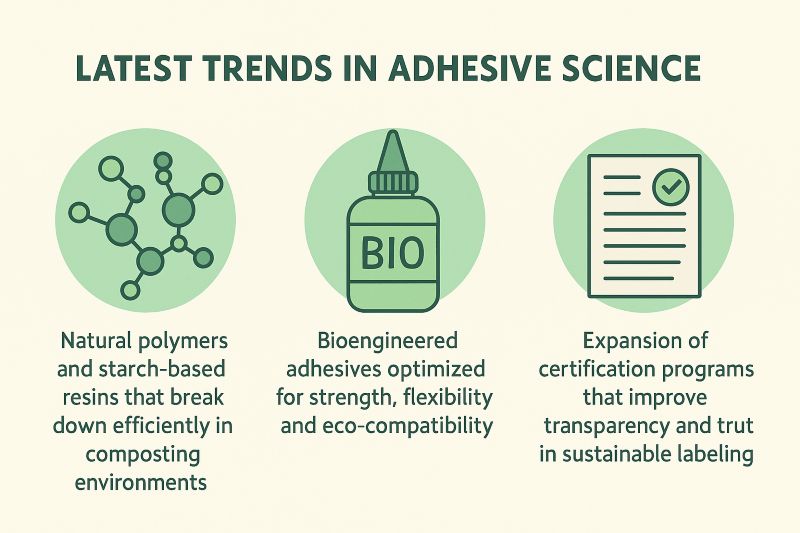
Definition of Biodegradable Adhesives
Types of Certified Adhesive Technologies
Importance of Biodegradable Adhesives
Methods of Certification
Latest Trends in Adhesive Science
Strategies for Implementation
Future of Biodegradable Adhesives
Frequently Asked Questions (FAQ)
Biodegradable adhesives are innovative bonding agents engineered to decompose naturally through microbial activity. Unlike traditional adhesives, they break down into non-toxic byproducts, helping reduce environmental impact. These adhesives are typically derived from renewable materials and undergo formal certification to verify their biodegradability under defined conditions. This makes them ideal for sustainable packaging, product assembly, and consumer goods.
Certified biodegradable adhesives come in various formulations, each developed to fulfill specific environmental and performance requirements:
Plant-based polymer adhesives: Sourced from renewable biomass, designed for general-purpose bonding.
Bio-resin adhesives: Engineered for strong performance and gradual decomposition.
Hybrid natural-synthetic blends: Designed to improve versatility while maintaining eco-friendly characteristics.
Each type is subjected to environmental testing to confirm that it breaks down efficiently without leaving toxic residues. These adhesives support circular economy goals across industrial and consumer applications.
Biodegradable adhesives are critical in the shift toward sustainable manufacturing. By decomposing into harmless substances, they help reduce landfill accumulation and carbon emissions. As global regulations and consumer demand increasingly prioritize green solutions, businesses that adopt biodegradable adhesives can significantly improve their environmental impact. These adhesives enable responsible sourcing and waste reduction, supporting a future that balances industrial growth with ecological preservation.
Certifying biodegradable adhesives involves a rigorous testing process that evaluates:
Biodegradation rate under laboratory-simulated composting or soil conditions.
Eco-toxicity testing to ensure no harmful byproducts are released.
Lifecycle assessments to verify sustainability from production through disposal.
Standardized certification bodies often require adhesives to meet criteria based on global environmental regulations. Only products that demonstrate complete and safe decomposition are granted certifications, helping consumers and manufacturers identify truly sustainable bonding options.
Recent advancements in adhesive science are focused on developing high-performance, certified biodegradable alternatives. Key trends include:
The use of natural polymers and starch-based resins that break down efficiently in composting environments.
Bioengineered adhesives optimized for strength, flexibility, and eco-compatibility.
Expansion of certification programs that improve transparency and trust in sustainable labeling.
These trends highlight the intersection of innovation, sustainability, and regulation—paving the way for adhesives that perform reliably without long-term environmental consequences.
To successfully integrate biodegradable adhesives into production or packaging systems, businesses should:
Assess material compatibility and performance needs.
Select certified biodegradable options suited for the specific application.
Train staff on storage, application, and disposal to maximize efficiency.
Work with verified suppliers to ensure continuous availability.
Track environmental metrics to align usage with sustainability goals.
These strategies not only improve ecological outcomes but also demonstrate a company’s commitment to corporate responsibility and innovation.
The future of biodegradable adhesives is driven by both environmental necessity and technological innovation. Research is expanding into:
High-performance bio-based chemistries that rival traditional adhesives.
Scalable, cost-efficient production methods to meet industrial demand.
Adhesives for advanced applications, such as electronics and medical devices, that also meet sustainability standards.
As regulations tighten and the green economy grows, biodegradable adhesives will become central to environmentally responsible design, manufacturing, and product life cycles.
What are biodegradable adhesives?
Biodegradable adhesives are bonding materials designed to break down naturally into non-toxic elements through microbial activity, reducing their long-term environmental impact.
What types of certified biodegradable adhesives exist?
These include adhesives made from plant-based polymers, bio-resins, and hybrid natural-synthetic formulations, all tested for safe and efficient decomposition.
Why are biodegradable adhesives important?
They help reduce landfill waste, minimize ecological damage, and support regulatory compliance, especially in industries adopting sustainable practices.
How are biodegradable adhesives certified?
Certification involves lab and field testing under specific conditions to ensure biodegradability, eco-toxicity safety, and full lifecycle sustainability.
What are the latest innovations in biodegradable adhesives?
Recent developments focus on high-performance, compostable formulations using natural materials, as well as expanding certification frameworks and industry applications.
How can businesses implement biodegradable adhesive solutions?
By evaluating operational needs, training teams, sourcing certified products, and monitoring sustainability KPIs in procurement and production processes.
What is the future outlook for biodegradable adhesives?
Continued growth is expected, with expanding use across packaging, automotive, construction, and electronics, driven by rising environmental standards and consumer preference.
Can biodegradable adhesives match the performance of traditional adhesives?
Yes, advancements in formulation have resulted in biodegradable adhesives that offer comparable—sometimes superior—bonding performance while delivering sustainability benefits.